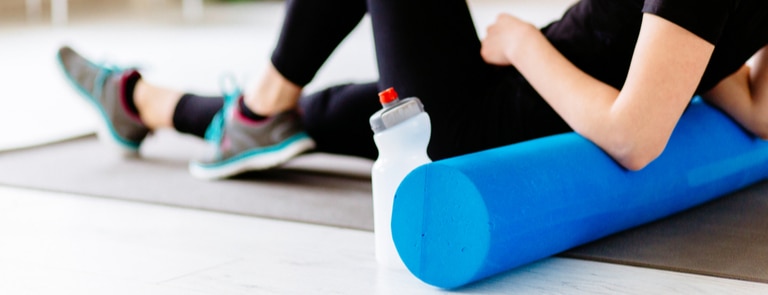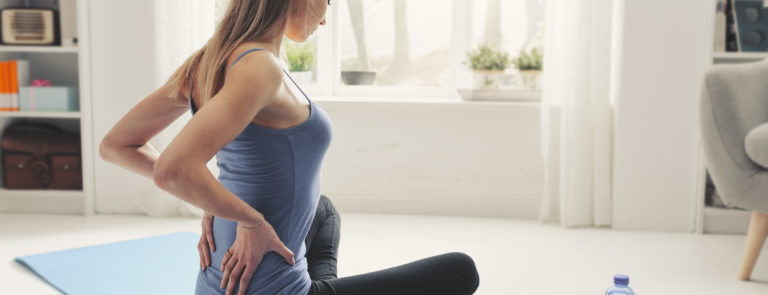20% off €40
5 reasons to use a foam roller

As we get older, muscle aches, stiffness and discomfort can become more of a regular thing.
Similarly, after a strenuous workout, our muscles can get stiff and sore – especially if it is the first time you have really moved in a little while!
While this is entirely natural, it is sometimes quite uncomfortable to deal with. And it can even be painful.
Foam rollers are a great way to relieve tight muscles and tension to help get you back on your feet.
But first, what exactly is a foam roller?
What are foam rollers?
It connects and surrounds all organs and has nerves that make it sensitive. When stressed, it tightens up, causing pain and tension.
Foam rollers were previously used exclusively by athletes, coaches and therapists. But today, they can help people of all sizes and ages release their aches, pains and discomfort.
You can read more about muscle health via our Health Hub.
Why use a foam roller? The 5 best foam roller benefits
Now you know what a foam roller is, you might be wondering how one can fit into your lifestyle and routine.
Below are five of the best ways a foam roller could help you:
-
Foam rollers can help reduce muscle pain
Studies suggest that foam rolling can help reduce muscle soreness after workouts.3
Another study found that foam rolling can alleviate muscle fatigue and soreness after bouts of intense exercise, helping to delay muscle soreness and improve performance levels.4
Foam rolling can sometimes feel uncomfortable, but this is because massaging separates and relaxes the muscle, reducing points of pain in the long run.5
-
Foam rollers may help improve blood circulation
Foam rollers can help to increase blood flow and circulation to the body’s soft tissue.6
This can enhance flexibility and range of motion, when your foam roller is used as part of a regular routine.
Massage naturally enhances the circulation of blood in the arteries, veins and capillaries by pushing blood into all avenues of the body.7
The result is that normal blood flow resumes as soon as pressure from the massage stops. Toxins also get pushed out through the body after the body’s lymph elements receive stimulation.
These toxins are driven out of the body through sweat, urination and defecation.8
-
Foam rollers may help break down muscle knots
Most people suffer from uncomfortable muscle knots from time to time
Muscle knots are myofascial trigger points.9 While they feel like balls underneath the skin, they are actually tightly contracted muscle tissue that is caught in an isolated spasm.10
After foam rolling the knots on your calves or back, you may notice that the discomfort eases for a short time. This is because foam rolling relaxes areas of tension and can help prevent spasming.
More painful, larger knots may need daily massages to help ease the discomfort.
-
Foam rollers can help prevent muscle injury
Foam rollers can help reduce the chance of injury.
During a workout, we put our muscles through stress by tearing the fibres so that they can grow and become stronger and bigger.11
Unfortunately, this means injuries are common. They mostly occur when the fibres have been overworked and become damaged or torn.12
Foam rollers can help target areas with the most tension and break up muscle knots to help prevent injuries from either forming or getting worse.
-
Foam rollers can help you relax
Many people find that adding foam roller exercises into their daily routine helps them to relax.
Painful points in the muscle cause stress and discomfort. They also rarely get better on their own.13
Treating the cause of this discomfort can help people feel better in themselves. Foam rollers help to lessen the source of the problem and boost feelings of relief and relaxation.
Foam rolling also encourages people to slow down and take five minutes to focus on themselves, releasing mental tension as well as physical stiffness within the body.14
- https://breakingmuscle.com/fitness/what-is-a-foam-roller-how-do-i-use-it-and-why-does-it-hurt
- https://www.hopkinsmedicine.org/health/wellness-and-prevention/muscle-pain-it-may-actually-be-your-fascia
- https://pubmed.ncbi.nlm.nih.gov/24343353/
- https://www.ncbi.nlm.nih.gov/pmc/articles/PMC4299735/
- https://www.self.com/story/what-foam-rolling-is-actually-doing-when-it-hurts-so-good
- https://www.cooperinstitute.org/2015/02/the-use-of-a-foam-roller-to-benefit-cardiovascular-health/
- https://www.fitday.com/fitness-articles/fitness/equipment/improve-your-circulation-with-a-foam-roller.html
- https://www.wellnessresources.com/health-topics/detoxification/toxin-removal
- https://www.tricitymed.org/2016/07/foam-rolling-getting-knots/
- https://www.healthline.com/health/muscle-knots
- https://www.medicalnewstoday.com/articles/319151
- https://www.avogel.co.uk/health/muscles-joints/muscle-strain/
- https://www.athletico.com/2014/05/01/what-is-a-muscle-knot
- https://fitonapp.com/self-care/calming-exercises/



